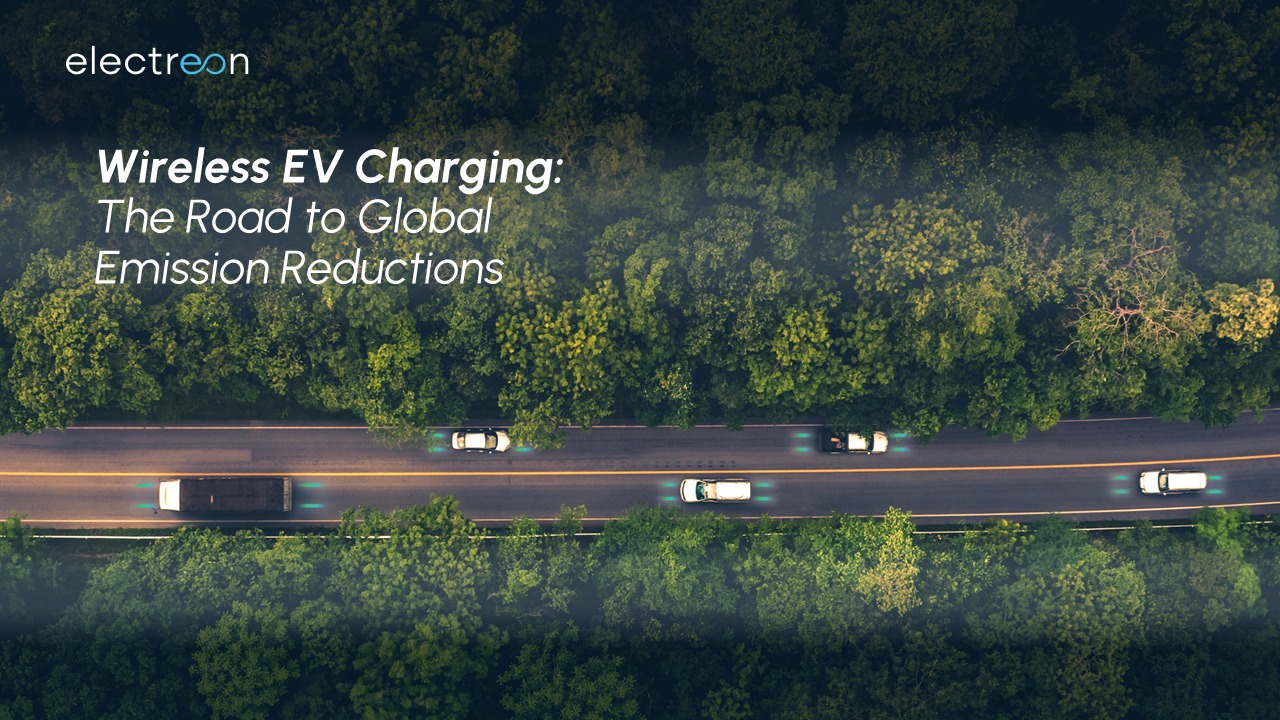
Wireless EV charging technology is not new but has yet to take the world by storm. In the transport sector, which accounts for 21% of worldwide emissions, wireless EV charging could present a credible solution to reduce CO2 emissions. Of the 21% of CO2 pollution generated by transport, 74.5% is caused by road vehicles. There is therefore a growing need for more sustainable and scalable EV charging solutions as private EV ownership is set to increase, and global EV fleet numbers – such as vans, buses, and trucks – are predicted to grow as well.
Research undertaken by Electreon explored the CO2 reduction impacts of four key benefits brought about through the company’s wireless EV charging technology. These benefits offer the opportunity of substantial reductions in CO2 emissions as a result of international and wide-scale adoption of Electreon’s wireless EV charging.
If deployed worldwide, Electreon’s technology could cut CO2 emissions by up to 635.4M tons per year, on average, between 2022 and the end of 2030. Read the full report here.
A scope of possible CO2 reductions
The research model was devised by Electreon and reviewed by Kenneth Gillingham, Professor of Economics at the Yale School of the Environment. Data was collected and analyzed across a range of low-end, mid-range, and high-end figures, to give a possible reduction of between 51.6 million and 635.4 million tons of CO2 per year, on average, from now until 2030. The total current global CO2 emissions figure per year sits at 51 billion tons, so at the high-end range of possible savings, about 1.25% of CO2 emissions could be prevented from escaping into the atmosphere.
The four key benefits of wireless EV Charging technology that can reduce CO2 emissions
A reduction in EV battery sizes
EV batteries are increasingly becoming a concern and a point of focus for many; EVs rely on batteries to operate and yet, batteries themselves carry carbon footprints and are still largely primitive in design. With a strong push towards optimizing battery size, performance, and overall technology, other means of reducing EV battery sizes may have been overlooked. Plug-in charging places huge requirements on the batteries of an EV–they must carry the EV from one point to another without consuming all the power beyond the EV’s available range. Wireless EV charging offers a means for EV battery reduction, simply by changing the requirements placed upon the battery. Specifically, with Electreon’s dynamic wireless charging, which enables EVs to charge via the road as they drive, the opportunity to charge along a vehicle’s route enables them to travel further with smaller batteries that can be “topped-up” during the day. This removes reliance on plug-in charging points, and instead focuses on multiple short, frequent, wireless charging points along the journey. With wireless charging, EVs can operate using smaller and fewer batteries, which reduces the need for additional batteries and subsequently reduces the CO2 emissions produced by battery production. Battery sizes also impact the total weight of the vehicle. This means that an EV operating the same route but with smaller batteries will also be lighter and therefore produce fewer emissions as well.
Replacing fossil fuel energy sources with renewable (solar) energy
Despite their clean and green intent, many EVs are reliant upon the electrical grid for power, which is mostly powered by fossil fuels, but also includes a smaller mixture of nuclear and green energy sources. Electreon’s technology for wirelessly charging EVs can be easily integrated with off-grid solar energy sources, removing the reliance upon the national grid and saving CO2 emissions.
Generating electricity on-site using renewable (solar) energy built onto existing infrastructure
There are endless unused miles of roadways, road corridors, and other road infrastructure, such as median walls, bridges, and verge banks. This existing roadway infrastructure is often overlooked as a part of the road, but Electreon’s wireless technology gives a new purpose to these features. Using median walls to house solar panels enables electricity generation to be localized and delivered straight to EVs on site. Without localized energy generation, reliance is placed on the national grid (mostly powered by fossil fuels) or on greener alternatives that might also carry a carbon footprint – such as solar farms. As helpful as these farms may be in curbing CO2 pollution, they can also carry their own environmental impact. In some regions (specifically, non-desert) where these farms are developed, large volumes of land acreage must be cleared, including tree populations that inhabit the land. Using on-site or near-site existing roadway infrastructure instead of relying on off-site solar farms to meet renewable energy goals for EV charging would help protect land acreage and tree populations, as well as curb CO2 emissions generated through the development of large-scale solar facilities.
Simultaneously charging multiple EVs as part of a shared charging platform
The demand for private and public plug-in EV chargers grows as the number of EVs increases. Creating a shared charging platform alleviates the need for developing additional plug-in charging stations, the production of which generates CO2 emissions. Curbing their production will therefore curb the overall manufacturing carbon footprint. Electreon’s wireless charging technology can facilitate the charging of multiple EVs at any given time from a single management unit, either as they drive, move slowly, or are parked.
Wireless charging can reduce CO2 emissions
With wireless EV charging technology offering up the possibility of reducing over 1% of global emissions per year, how can we achieve wide-scale deployment? These CO2 emissions are only possible if an ecosystem of stakeholders come together to change the transport sector for good. Instances of this are already happening in Europe, with Germany’s eCharge project and Italy’s Arena of the Future project. However, more companies, corporations, and communities must continue to work together to bring environmentally-friendly solutions to the transportation sector and directly tackle the emissions that we so desperately need to curb.
Read the full report here.
Speak to us about EV charging solutions for your fleet or municipality here.